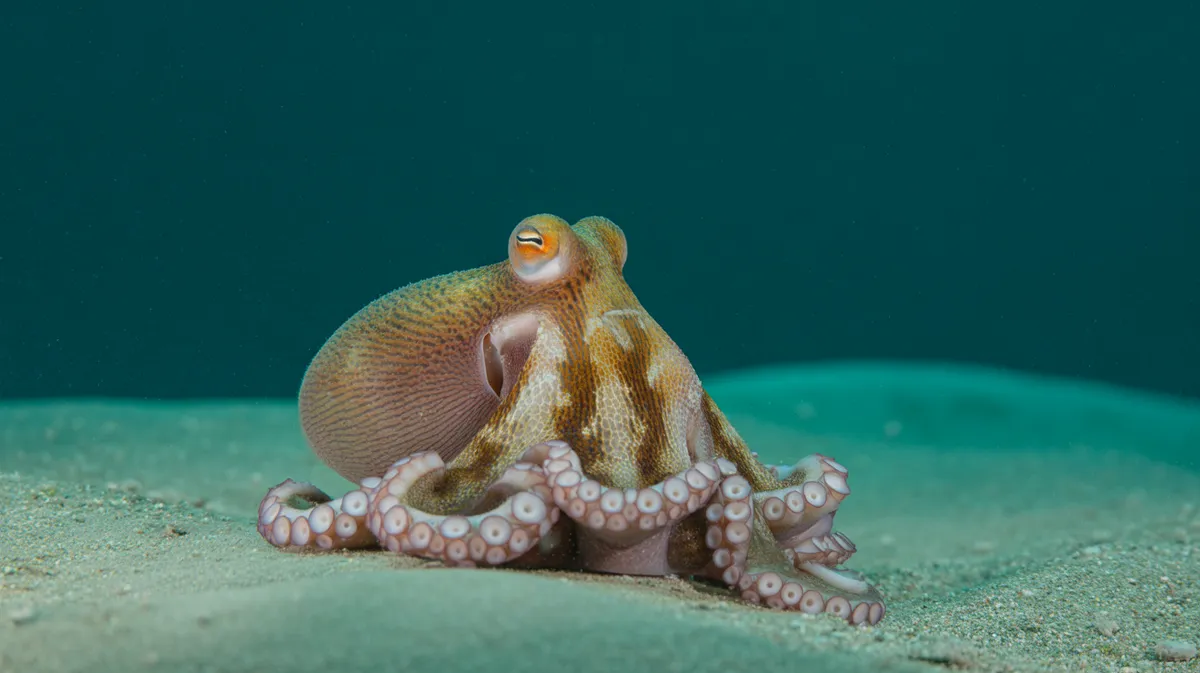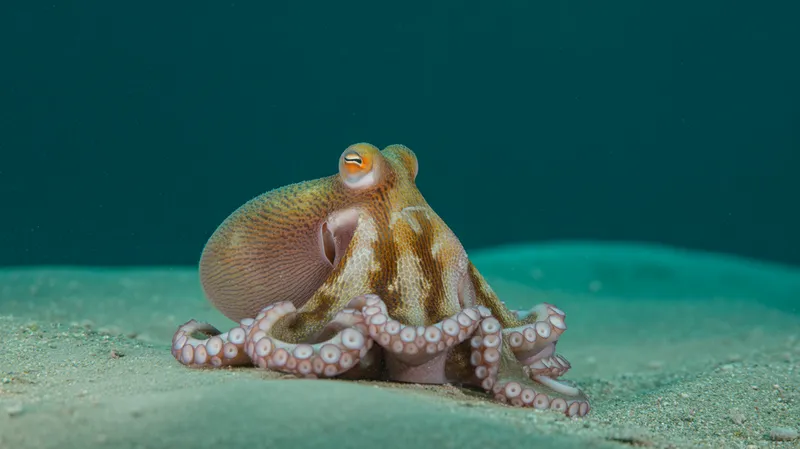
Coconut octopus
Amphioctopus marginatus

Meet the Coconut octopus
The coconut octopus is a medium-sized cephalopod known for its remarkable intelligence and unique behavior. It inhabits sandy and muddy sea floors in tropical waters of the western Pacific and Indian Oceans. This octopus is famous for its use of coconut shells and seashells as portable shelters, which it carries and assembles for protection. Its arms are banded and its body is mottled brown and white, allowing it to blend seamlessly with its surroundings.
Classification
Invertebrate
Habitat
Shallow coastal waters, sandy and muddy sea bottoms
Diet
Carnivore
Lifespan
1-2 years
Conservation
Least Concern
Weight
300-500 grams
📖Fascinating Facts
Tool User
The coconut octopus is one of the few invertebrates known to use tools, carrying and arranging coconut shells as portable shelters.
Bipedal Walking
This octopus can walk on two arms while holding its body off the ground, a behavior rarely seen in marine animals.
Master of Disguise
It can rapidly change its skin color and texture to blend in with sandy or muddy sea floors, avoiding detection by both prey and predators.
📋Detailed Description
Amphioctopus marginatus, commonly known as the coconut octopus or veined octopus, is a medium-sized cephalopod reaching mantle lengths of up to 15 cm and arm spans of approximately 50–60 cm. Its body is characterized by a smooth, muscular mantle with a mottled brown and white coloration, which provides effective camouflage against sandy and muddy substrates. The arms are distinctly banded and lined with two rows of suckers, enhancing both grip and tactile sensitivity. This species possesses highly developed eyes with horizontal slit pupils, granting acute vision for detecting prey and predators. The coconut octopus is notable for its remarkable intelligence, demonstrated through complex problem-solving abilities and advanced tool use, such as carrying and assembling coconut shells or seashells for shelter. It is a solitary animal, typically found in shallow coastal waters (depths of 3–25 meters) across the western Pacific and eastern Indian Oceans, including Indonesia, northern Australia, and the Philippines. Its locomotion is diverse, employing both jet propulsion and unique bipedal or quadrupedal walking using its arms. The species is primarily nocturnal, emerging at dusk to forage. Its diet consists mainly of crustaceans, mollusks, and small fish, which it captures using stealth and rapid arm movements. The coconut octopus exhibits a short lifespan, generally living for 1–2 years, with rapid growth and high reproductive output.
💡 Did you know?
The coconut octopus can assemble multiple shells or coconut halves into a fortified shelter, demonstrating advanced problem-solving skills.
🔬Research & Sources
Wikipedia Summary
Amphioctopus marginatus, also known as the coconut octopus and veined octopus, is a medium-sized cephalopod belonging to the genus Amphioctopus. It is found in tropical waters of the western Pacific Ocean. It commonly preys upon shrimp, crabs, and clams, and displays unusual behavior including bipedal and quadrupedal walking as well as tool use.
Last Modified: 2/16/2025
🎭Behavior & Social Structure
The coconut octopus displays a repertoire of sophisticated behaviors rarely observed in invertebrates. It is renowned for its tool use: individuals have been documented selecting, transporting, and assembling coconut shell halves or bivalve shells to construct portable shelters, which they use for protection against predators. This behavior involves planning and manipulation, indicating advanced cognitive abilities. Hunting is typically ambush-based; the octopus buries itself in the substrate or hides within its shelter, extending its arms to snatch passing prey such as shrimp, crabs, and small fish. It uses its sharp beak to penetrate hard shells and injects venom to immobilize prey. Locomotion includes crawling, jet propulsion, and a unique bipedal gait in which it walks on two arms while camouflaging its body with debris. Social interactions are minimal, as the species is largely solitary except during mating. Daily routines involve hiding during daylight hours and actively foraging at night. When threatened, it employs rapid color changes, ink ejection, and swift retreat into its shelter.
👶Reproduction & Life Cycle
Amphioctopus marginatus is gonochoric, with separate male and female individuals. Mating involves the male transferring spermatophores to the female using a specialized arm called the hectocotylus. Courtship is brief, and copulation can last several minutes. Females lay clusters of elongated eggs (up to several hundred) within a secure den, often constructed from shells or debris. The female guards and aerates the eggs for several weeks (typically 30–80 days, depending on water temperature), abstaining from feeding during this period. After hatching, planktonic paralarvae emerge and drift in the water column before settling to the benthos. Like most octopuses, the coconut octopus is semelparous: females die shortly after the eggs hatch, and males also have a short post-mating lifespan. There is no parental care beyond egg guarding, and breeding can occur year-round in tropical regions, though peaks may align with local environmental cycles.
🛡️Adaptations & Survival
The coconut octopus exhibits a suite of adaptations for benthic life and predator avoidance. Its chromatophores and iridophores enable rapid color and texture changes, providing effective camouflage. The species’ intelligence and problem-solving skills facilitate tool use, a rare trait among invertebrates, allowing it to construct mobile shelters for defense. Its flexible, muscular arms and sensitive suckers enable precise manipulation of objects and efficient prey capture. The ability to walk bipedally or quadrupedally on arms allows for stealthy movement across open substrates, reducing exposure to predators. Its venomous saliva aids in subduing hard-shelled prey. The octopus’s short generation time and high fecundity are evolutionary strategies to offset high juvenile mortality in dynamic coastal environments.
🎨Cultural Significance
While not a major figure in traditional folklore, the coconut octopus has gained attention in popular media and scientific outreach due to its remarkable intelligence and tool use, often featured in documentaries and educational materials. In some regions, it is harvested for food, but it does not have significant ritual or symbolic roles. Its behaviors have inspired discussions about animal cognition and have contributed to shifting perceptions of invertebrate intelligence.
🔬Recent Research & Discoveries
Recent research has focused on the cognitive abilities of Amphioctopus marginatus, particularly its tool use and problem-solving skills. Notably, a 2009 study published in Current Biology provided the first documented evidence of tool use in octopuses, with individuals observed transporting coconut shell halves for later use as shelter. Ongoing studies investigate the neural basis of these behaviors, ecological impacts of habitat modification, and the species’ responses to environmental stressors. Genetic research is clarifying its phylogenetic relationships within the Octopodidae. There is also interest in its potential as a model organism for studying cephalopod cognition and behavioral ecology.
🎥Wildlife Videos

Masterminds: Secrets of the Octopus (Full Episode) | National Geographic
Octopuses break all the rules on animal intelligence. Born into the world as orphans, they are self-taught masterminds; capable of ...
National Geographic

Wildlife - Just Octopuses | Free Documentary Nature
Wildlife - Episode 6: Just Octopuses | Wildlife Documentary Watch 'Wildlife - Episode 7' here: https://youtu.be/o7lmfFrtF_I Take the ...
Free Documentary - Nature

An Octopus' Coconut Home
“Octopus: Making Contact“ premieres Wednesday, October 2 at 8|7c on PBS --------------- For full NATURE episodes, check out ...
Nature on PBS

Squids & Octopuses - Mysterious Hunters of the Deep Sea | Free Documentary Nature
Squids & Octopuses - Mysterious Hunters of the Deep Sea | Ocean Documentary Octopuses and squids are anything but cuddly ...
Free Documentary - Nature

Spy Octopus Helps Friend Hide From Shark
An unlikely ally helps a coconut octopus escape sharks. Please LIKE and SUBSCRIBE if you enjoyed it! http://bit.ly/1Adl6ht ...
Nature on PBS

A Sneaky Coconut Octopus Uses Tools to Snatch a Crab 🦀
Coconut octopuses are among the most intelligent invertebrates around: They use tools, carry their shelters around for when they ...
Smithsonian Channel
🌍Habitat Information
The Coconut octopus typically inhabits Shallow coastal waters, sandy and muddy sea bottoms environments. Coconut octopuss have adapted to their environments with specialized features and behaviors.
Primary Habitat:
Shallow coastal waters, sandy and muddy sea bottoms
More detailed habitat information will be available soon.
🛡️Conservation Status
The Coconut octopus is currently classified as Least Concern. Conservation efforts are crucial for preserving this species for future generations.
Common Threats:
- 🏠Habitat loss and fragmentation
- 🌡️Climate change impacts
- 🎯Hunting and poaching
- 🏭Human-wildlife conflict
⚠️Threats & Conservation Challenges
Currently assessed as Least Concern by the IUCN, Amphioctopus marginatus faces few immediate threats due to its wide distribution and adaptability. However, localized pressures include habitat degradation from coastal development, pollution, and destructive fishing practices such as trawling, which can damage benthic habitats. The species is occasionally collected for the aquarium trade and as bycatch in artisanal fisheries. Climate change poses potential long-term risks through ocean warming, acidification, and changes in prey availability. Population trends are not well-documented, but the species’ high reproductive rate and broad range provide some resilience against localized disturbances.
🔬Scientific Classification
Scientific Name
Amphioctopus marginatus
Classification Hierarchy
🔍 About Taxonomic Classification
Taxonomic classification is a hierarchical system used by scientists to classify and organize living organisms based on shared characteristics and evolutionary relationships.
The system moves from broad categories (Kingdom) to increasingly specific ones, with each animal's scientific name typically consisting of its Genus and species.
📝Community Notes
Share your observations and insights about the Coconut octopus with our community of wildlife enthusiasts.
Join Our Community
Sign in to share your observations and connect with fellow wildlife enthusiasts.
Sign In to ContributeNo community notes yet
Be the first to share your observations about the Coconut octopus!
Explore Coconut octopus
Select a tab above to learn more about this amazing animal.
📸Photo Gallery
No photos available for this animal yet.
🌟Discover More Wildlife
Continue your journey of discovery with more fascinating animals from our database
